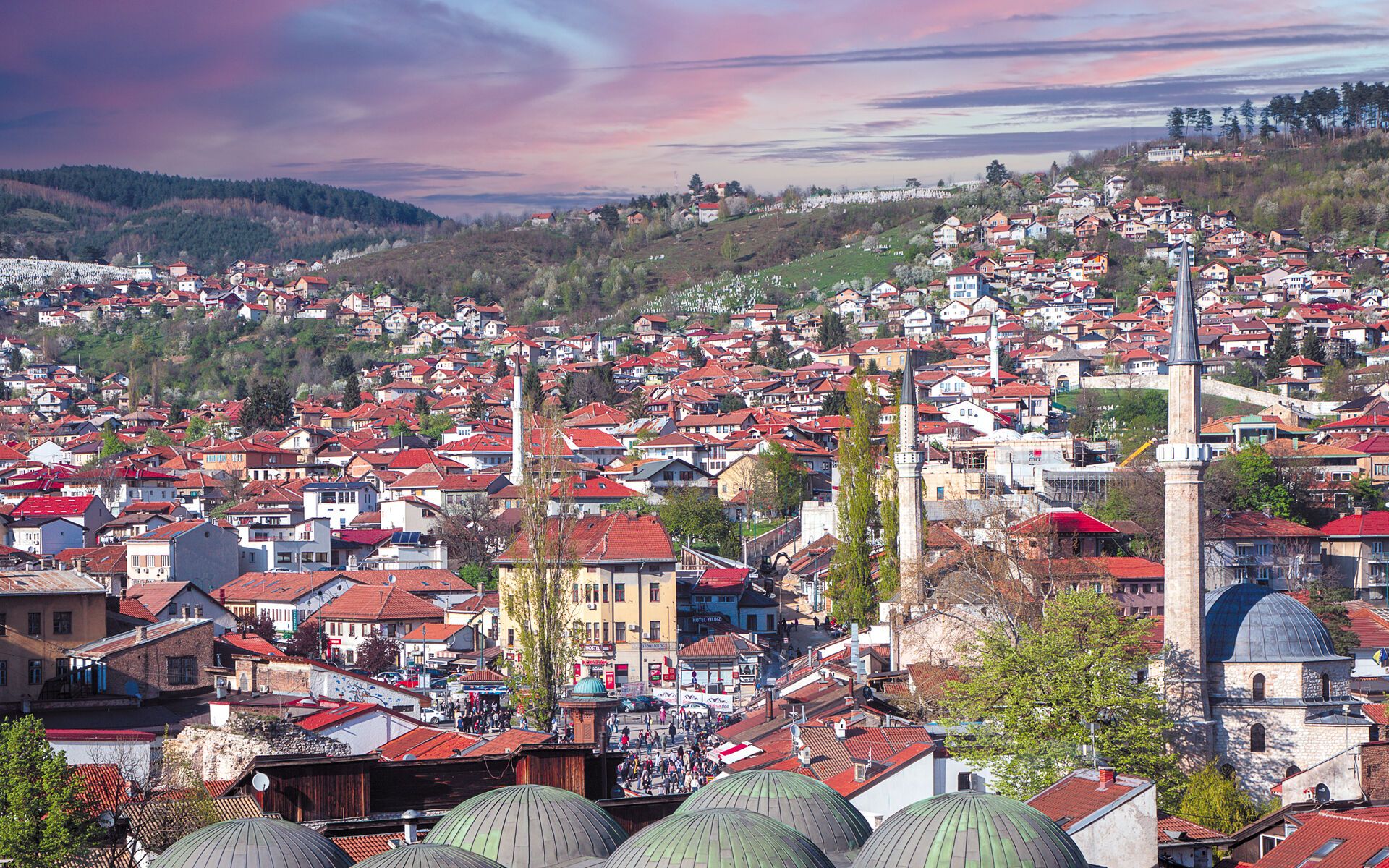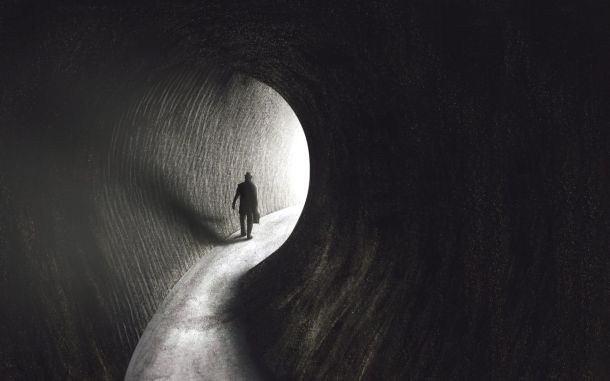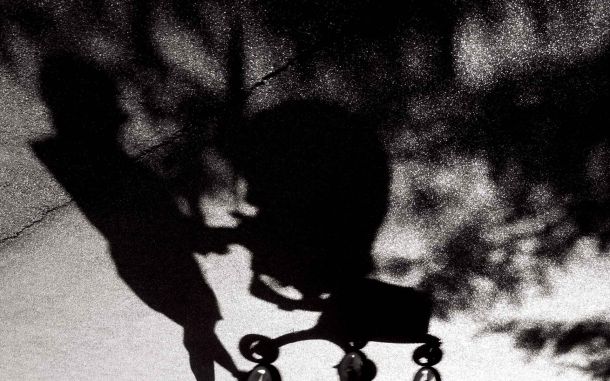Minarets in the Mountains

In This Article
-
The call to prayer in Sarajevo must be something of a novelty for many of the tourists. The magic prevails, however, for there can be no more compelling sound in a public place than this most evocative call to piety.
-
Due to the massive influx of refugees, there is today a burgeoning Muslim presence in Europe. Tharik Hussain’s quest, however, was to visit and research the indigenous Muslim populations within the Balkan states, populations that have been in Europe for centuries.
-
Who would have known that the Ottomans were so interesting? Tharik Hussain reminds us that Muslims have long been in Europe. The book is wonderfully descriptive of a European Muslim presence, which has been there for centuries and has often been overlooked.
The Ottoman Empire had absorbed Bosnia by the middle of the 15th century, and the Ottomans were to leave indelible marks on the Balkans for centuries to come. One demonstration of prowess was built in 1566 through the inspired vision of the architect Mimar Hajrudin: the Stari Most, which was, and is again, one of the world’s most imposing bridges, soaring over the Neretva River at Mostar in Bosnia and Herzegovina.
The bridge, which in our time connects the largely Catholic population on the Neretva’s west bank to the Muslim population on the east bank, was destroyed in 1993 during the Yugoslav conflict. On an earlier visit to Bosnia and Herzegovina, I found many of Mostar’s walls still pockmarked by shellfire. The Stari Most, however, was rebuilt between 2001 and 2004 to perfect proportions of the original, at a cost of 12.5 million euros and was designated a UNESCO World Heritage Site. The houses around it were still in a sorry state, though.
What did it all mean? Perhaps historically it was meaningless as far as our inclinations for war are concerned. The war had come and gone. Bosnia and Herzegovina were disputed on all sides and abused when the former Yugoslavia splintered. The Bozniak Muslim population was cornered and fired upon from the heights surrounding the city. It was horrible. It is always devastatingly horrible. We should hang our heads in shame. In fact, we saw a book titled Shame On You Europe. It seemed pointless to buy the book. There are many ambitious forces in the world, and ambition, geopolitically, seems to have led to war.
Eighteen years on, and we were about to visit again Bosnia and Herzegovina. We drove down from Austria, through Slovenia and Croatia. As we drew closer to Sarajevo, passing through what is a lush green landscape, we saw minarets spiking the sky, marking even the smallest villages.
Sarajevo today is gorgeous and not a little hectic. They sure drive fast in the city, and there seemed to be a Dervish-like whirl of dense traffic. The call to prayer must be something of a novelty for many of the tourists. The magic prevails, however, for there can be no more compelling sound in a public place than this most evocative call to piety. Many of the women in Sarajevo wore the hijab. True, some of the souvenirs may possibly be Made in China, but there is sufficient local color and exoticness to make your head swivel. We drank an awful lot of Turkish coffee, and none of it was awful. Nor was the baklava, or the ubiquitous Turkish delight. You can have falafel and doner kebabs coming out of your ears.
There are more restaurants of all stripes than is decent for any capital city, and they are densely concentrated in Baš?aršia, which as the word suggests is a bazaar district, and is situated close to the Miljacka River. Our favorite restaurant was just across the river. Check out Inat kucá (House of Spite), which obviously has a history that explains the name. The ambience, the interior design and architecture—and the food—are wonderful, and they speak perfect American English.
In the heart of the bazaar, the famous Gazi Husrev-Beg Mosque rests serenely amid the clamor and flow of the crowded lanes around it. I approached the door but the prayers had just finished, the imam was deep in conversation, and I turned away.
The Caffe Divan is situated in a lovely inner courtyard. There are many Muslim customers, and the background music is a part of the Islamic atmosphere. Within the courtyard, flanking the cafe, is the magnificent “Isfahan” carpet shop. Their motto is, “The purpose of our art is to wipe off the dust of everyday life from our souls.” They have carpets, and plenty more artefacts besides, that are the stuff of dreams and ruined bank accounts. Above the courtyard, up a steep flight of stairs, was an exhibition of calligraphy. The artist is a genius, or a genii, probably both.
The visit was too short with respect to what Sarajevo has to offer. Our taste for the Islamic world briefly sated, we left heading south. A book fell to hand that told more about Sarajevo and the Balkans than could ever be recorded on what was little more than our weekend trip. Tharik Hussain has an impressive body of work to his name, including an award-winning radio program for the BBC on America’s earliest mosques and his recently published Minarets in the Mountains – a Journey into Muslim Europe was excitedly purchased. Hussain receives top marks for this book, in which he traces the footsteps of Evliya ?elebi, the Turkish Marco Polo, to seek out the Muslims of the Balkans. Evliya ?elebi’s Seyahatname – Book of Travels runs to ten volumes and is widely available in Turkish. Only extracts are apparently available in English. An Ottoman Traveller: Selections from the Book of Travels of Evliya ?elebi, edited and translated by Robert Dankoff and Sooyong Kim appears to be a standard work.
Due to the massive influx of refugees, there is today a burgeoning Muslim presence in Europe. Tharik Hussain’s quest, however, was to visit and research the indigenous Muslim populations within the Balkan states, populations that have been in Europe for centuries. Other than the obvious attractions of Sarajevo, Mostar, and Dubrovnik, the central mass of Balkan territories generally pass unseen beneath the wings of tourists flying south seeking Mediterranean sunshine. Hussain undertook a circuitous motor tour—taking his wife and two daughters with him—that included Bosnia and Herzegovina (population around 52% Muslim), Serbia (3%), Kosovo (95%), Bulgaria (10.8%), North Macedonia (32%), Albania (82.1%), and Montenegro (20%). Almost none of these countries are hot-spot tourist destinations, but there is a hugely diverse and rich cultural heritage to be found, and as the statistics show, an appreciable percentage of it is Muslim.
Hussain begins and ends his tour in Sarajevo. He writes, “The minarets seemed to be everywhere and is testimony that Sarajevo had always been a Muslim city, founded in 1461, two years before Sarajevo became an Ottoman district.” As a Muslim, Hussain’s first duty was to visit the Gazi Husrev-beg Mosque. He relates that the proceedings there were attuned to Turkish inspiration, in which chapters of the Qur’an were recited ahead of congregational prayer. Hussain’s text is beautifully written and explanatory of Islamic history in the city. The first chapter alone makes purchasing this book worthwhile. The war and the fate of Sarajevo are covered, of course. But Hussain does not dwell too much upon what is common knowledge concerning the horrors the people endured. The text otherwise sparkles.
His first stop after Sarajevo was Mostar, and then some smaller Muslim centers. Then came Visigrad and the border to Serbia. The part of Serbia they then headed for was “…so Muslim it was like Turkey,” Tharik relates. Despite the low percentage of 3% Muslim throughout Serbia, this amounted to the biggest surprise of the entire trip: Novi Pazar in Serbia is 80% Muslim. The entire atmosphere of the place tells of Ottoman influence. Hussain relates: “…I had to check that we had not crossed a border somewhere into Turkey.” There are a reported 66 mosques in Novi Pazar serving a Muslim population of almost 83,000. The obvious conclusion for any traveler seeking Muslim culture in the region, is that Novi Pazar would be a must visit. Tharik devotes more than 20 pages of sparkling prose to the town.
The journey continued to Pristina, the capital of Kosovo, and a chapter titled “The Grandfather of Muslim Europe.” The grandfather was Sultan Murad I who reigned in the 14th century. His tomb was visited by Evliya ?elebi and one Melek Pasha. What followed was a very enlightening description of Kosovo’s history. The modern history of Kosovo is devastatingly depressing. The 1998 conflict saw the rise of the Kosovo Liberation Army when autonomy was refused. Independence was achieved only in 2008 after NATO intervention. 95% Muslim, Kosovo is the most Muslim country in Europe. The chapter covered a great deal of Ottoman history and was enhanced by some excellent descriptions of religious observance.
Then over the border again into Serbia and the city of Niš, which is where resolute tourists stop overnight on their drive from the north of Europe to Thessaloniki and the rest of Greece.
Niš is now a modern metropolis and described as “…an orthodox town, with only the faintest whiff of its lengthy Muslim heritage.” Nevertheless, it turned out to be as full of Ottoman history as elsewhere, but there are now pedestrian zones, malls, and shopping centers. There’s a sufficiency of monuments, as well as a fortress of the 1st century AD covering 22 acres of parkland. There were additions to the architecture and plaques confirming 18th century Ottoman origins.
Then came the short drive across the border to North Macedonia and the capital, Skopje. The chapter began with an obscene rant by a Greek who was very upset about Macedonia, which amounted to a Hellenic nightmare since, as Tharik mentions, “I stood before a Disneyfied Hellenic fairground – though even Disney wouldn’t have got it this wrong.” Greeks are angry about the situation, claiming Macedonia to have originally been Greek. Alexander the Great, however, employed a great many Macedonians in his army, which probably added to the confusion. With 32% of the population being Muslim, there is a fair amount of Ottoman influence to counteract what can only be described as modern misdemeanors. The Sultan Murad Mosque is in a tourist-free area.
Albania followed. Some visitors speak of safety concerns, but Tharik Hussain, his wife, and two young daughters in tow were warmly welcomed and given all manner of assistance. In the deep south of the country lies Gjirokastër, which is designated “A Town Addicted to Prayer.” In Evliya ?elebi’s day, it was known as Egiri, and there had been at least fifteen mosques. It was where scholars of the Hadith came to train. In fact, it is the birthplace of the dictator Enver Hoxha who between 1944 and 1985 undertook to make Albania the first atheist state. Paradoxically, Hoxha’s father had been an imam. But Hoxha killed religion and all who dared oppose him in Albania in purge after purge of vicious excess. Together with some beautiful villages and sites of interest, including the capital, Tirana, a goodly amount of Albanian history was given in the following chapters.
Further reading may include Journals of a Landscape Painter in the Balkans – Edward Lear in Albania. A wonderful, almost poetic book by a sensitive artist about a 1848 tour. The paintings are lovely. Ottoman references abound in what in those times was known as Turkey in Europe. One can’t resist mentioning that Lear also wrote immortal verses for children, including the irresistible The Owl and the Pussycat.
What followed for Hussain, of course, was another border crossing and the Bay of Kotar in Montenegro. Here your correspondent is on familiar ground. We were astonished to find that the euro was the given currency. Apparently, a dispensation from Brussels had acknowledged the inevitable: that Montenegro would eventually be a member state of the EU, and that they needed a new currency following Yugoslavia’s splintering. But Montenegro is not just meant for tourists. 20% of the population is Muslim; there is reason enough for Hussain to visit. The capital, Podgorica, is related to have been little more than a provincial town in the 15th century when the Ottomans arrived. But Evliya notes the town was sufficiently important for the conquering sultan, Mehmet II, to build a fortress there. Together with a visit to the Osmanagic Mosque, Hussain’s indefatigable drive to see everything and, above all, to meet people, continued.
Then back to Bosnia and Herzegovina he went, visiting sites of interest both large and small. Not to be missed was Blagaj, about ten kilometers southwest of Mostar, and the traditional Dervish House. This Sufi brotherhood residence has been called the “the most peaceful place in Bosnia”—and it’s gorgeous, too. Mostar was visited on an extended tour of the country, ending in Sarajevo. There was again an extensive chapter about the city. Followed by a very useful glossary of terms.
With 338 pages of vividly related travel and religious history, the book also sparkles with some excellent color photographs. Who would have known that the Ottomans were so interesting? Tharik Hussain has reminded us that Muslims have long been in Europe. The book is wonderfully descriptive of a European Muslim presence, which has been there for centuries and has often been overlooked. It should be read by everyone, especially Muslims, interested in taking a vacation or study trip in the Balkans.









